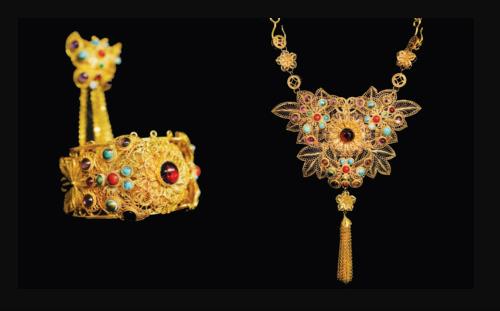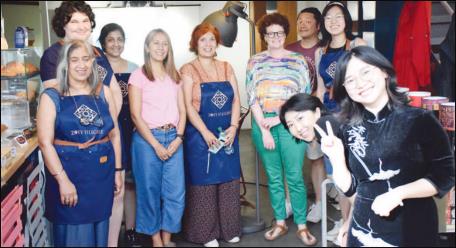Jewelry designer lights up London with filigree inlay pieces

A set of filigree inlay jewelry by Zou Xuewen, called Fang Fei Ji, which draws inspiration from the traditional Chinese motif of flower and butterfly. [Photo provided to China Daily]
Imagine transforming gold and silver into threads as delicate as a strand of hair, meticulously knitting them into intricate lace that represents a blooming flower, with precious gems carefully inset onto the delicate petals — this is the art of filigree inlay, a traditional Chinese court jewelry technique also known as "fine gold art".
Zou Xuewen, a young jewelry designer and inheritor of the filigree inlay technique, a designated intangible cultural heritage in China, has been introducing this ancient craft to the United Kingdom through workshops, lectures, and exhibitions.
"Many of today's Western jewelry-making techniques have royal court origins and are employed by renowned brands such as Van Cleef& Arpels and Buccellati," remarked Zou, who established her brand, Zoey Filigree, in 2021. "I aspire to showcase Chinese jewelry techniques to the world through my creations."
In January, Zou unveiled a new collection featuring jewelry pieces that combine Chinese calligraphy characters meaning "today" and "faraway" with floral designs.
"It is an exploration of the balance between the practical and the ideal," she explained, expressing her intention to incorporate more Chinese calligraphic characters into filigree jewelry.
Crafting a piece of jewelry with filigree inlay is a time-consuming process, taking months to complete. It involves a series of intricate steps such as nipping, plaiting, jointing, piling, filling, and knitting delicate gold or silver threads.
The history of filigree inlay dates back to China's Warring States Period (475-221 BC). With advancements in techniques for creating thin gold and silver threads, the art matured during the Tang (618-907) and Song (960-1279) dynasties, reaching its zenith during the Qing (1644-1911) Dynasty.
Zou's fascination with traditional Chinese filigree inlay jewelry began during a master's program in jewelry design in London that she began in 2018. Amid a curriculum focused on modern jewelry design, Zou found herself drawn to traditional techniques, discovering filigree inlay through an online video featuring Zhao Yunliang, an esteemed master of the technique in Beijing.
"When I got into the college, I wasn't so sure what I liked so I studied different jewelry-making techniques on my own until I came across the filigree inlay in the online video," she recalled.

Zou Xuewen (on right) poses for a photo with participants at a workshop on Chinese jewelry techniques in London in 2023. [Photo provided to China Daily]
In the video, Zhao, whose teachers inherited the technique from the Qing court's jewelry studio, reflected his career such as his participation in making national jewelry presents in the 1990s and creating jewelry props for films.
"I was so impressed by the artisan spirit of the masters in passing on the centuries-old technique and wanted to study filigree inlay with him," said Zou, adding that through several connections she finally got in contact with Zhao who was very pleased with her determination and agreed to take her as an apprentice in 2019.
Zou then suspended her study in London and went back to Beijing to learn the filigree inlay technique.
"But the technique was much harder to learn than I imagined. I started from making the gold thread, which is so thin that a small mistake in soldering could ruin one week's work," recalled Zou.
Zou achieved the status of intangible heritage inheritor of the filigree inlay technique in 2022 with the first of her major works — a set of filigree inlay jewelry called Fang Fei Ji, including a ring, a bracelet and a necklace, which draws inspiration from the traditional Chinese motif of flower and butterfly.
The jewelry piece participated in the London Design Festival in 2022 and Milan Fashion Week in 2023, during which Zou's jewelry garnered the interest of many people in the exhibition, and she then opened a workshop providing courses and experience in jewelry-making for the public at the workspace for creative entrepreneurs at Hotel Elephant in London.
"After five years of studying this technique, I still dare not say that I have mastered it," she said. "I remain a humble student in this trade but I want to introduce this ancient technique to today's people."
To make the ancient skill more accessible to modern tastes, Zou incorporates modern designs and techniques into her workshops, teaching customers enamel and lacquer bead jewelry techniques. During the past two years, she has taught more than 100 individuals and delivered lectures on various occasions.
"The art of jewelry embodies the aesthetics and values of a nation, and filigree inlay technique reflects the meticulous and inclusive nature of Chinese people," said Zou.
She also highlighted the importance of cross-cultural exchange, noting how exhibitions in London exposed her to concepts and designs from other nations.
"The heritage of one nation can be appreciated by the world," Zou said. "With the continuous efforts of our overseas Chinese artists, the traditional filigree inlay technique will cast its unique light onto the world."
Related articles
-
 Chic on display
Chic on displayMore
-
 Jakarta Fashion Week 2023
Jakarta Fashion Week 2023More
-
 OOTD (Rural Version): A Fashion Design Full of Imagination
OOTD (Rural Version): A Fashion Design Full of ImaginationMore
-
 In pics: Milan Men's Fashion Week Spring/Summer 2024
In pics: Milan Men's Fashion Week Spring/Summer 2024More
-
 China Fashion Week 2023 spring/summer shows wrapped up in Beijing
China Fashion Week 2023 spring/summer shows wrapped up in BeijingMore
-
 Feature: Gaza young lady masters horror cinematic make-up
Feature: Gaza young lady masters horror cinematic make-upMore
